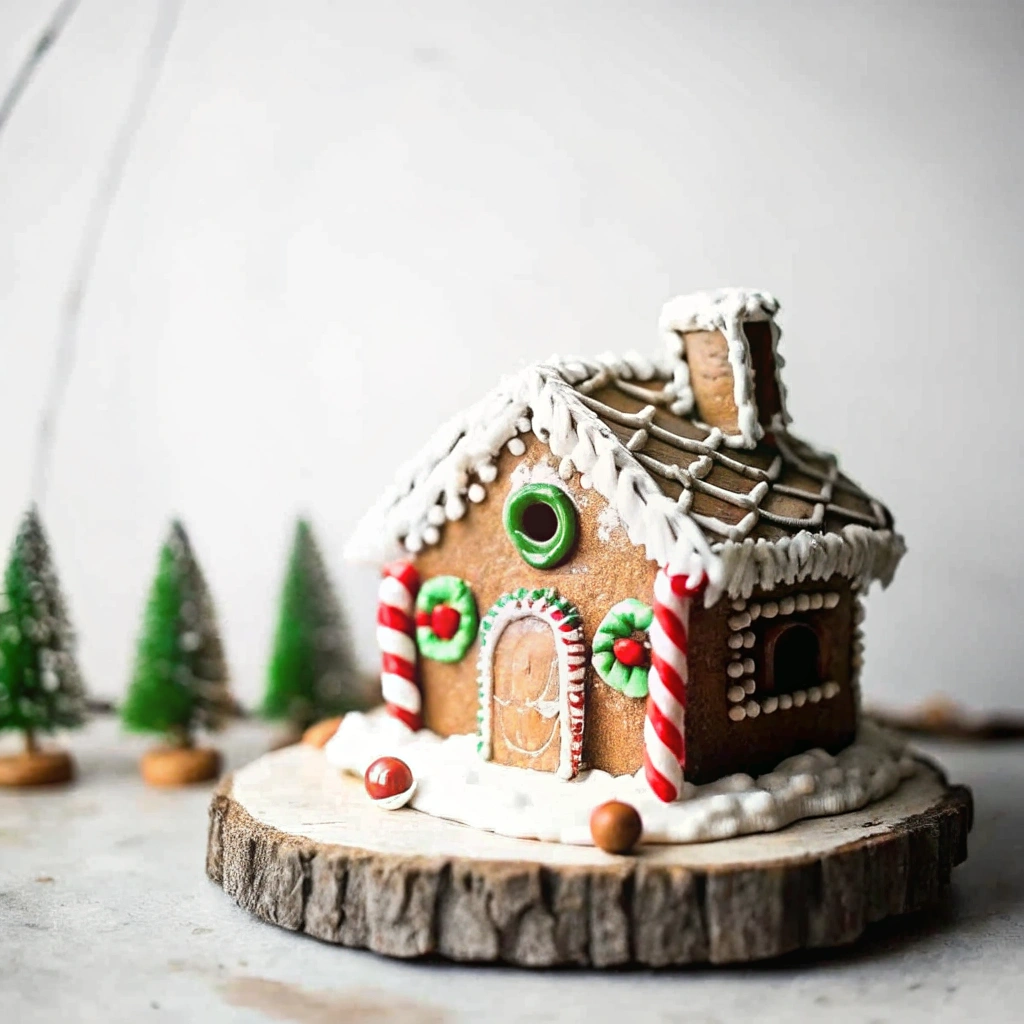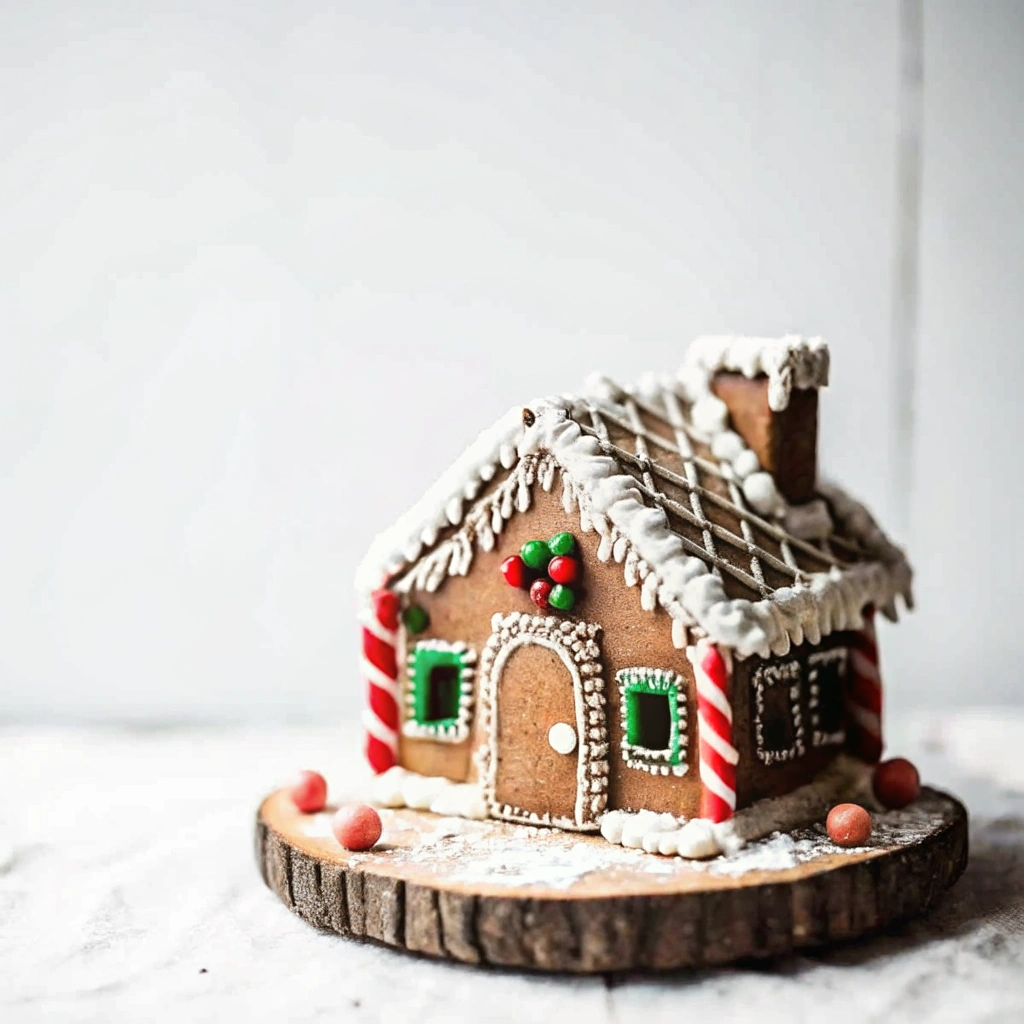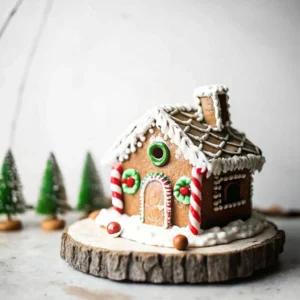
Nothing captures the magic and nostalgia of the holidays quite like a perfectly constructed Gingerbread House. This isn’t just a dessert; it’s a cherished annual project, a stunning centerpiece, and a true labor of love. However, the path to a sturdy, impressive gingerbread house is often paved with collapsed roofs and runny icing.
This recipe is your definitive guide to success. We use a specialized, no-spread gingerbread dough that bakes flat and hard (essential for structural integrity) and pair it with the ultimate royal icing recipe—which acts as the cement holding your winter wonderland together. We’ll walk you through the entire process, from preparing the templates to the final snow-dusted decorations.
Get ready to skip the frustration and jump straight to the fun. This guide ensures your Gingerbread House stands tall and proud as the unforgettable centerpiece of your holiday season!
Why This Gingerbread House Recipe is Structurally Sound
Unlike soft, chewy gingerbread cookies, a gingerbread house requires dough that is engineered for construction. Our recipe achieves this crucial stability through a few key adjustments:
- Low Leavening Agents: We use very little or no baking soda and baking powder. Leavening causes air bubbles, which results in softness and spreading—the enemy of a stable structure. This dough stays flat and hard.
- Reduced Fat and Moisture: This dough has a slightly lower fat content than standard cookies, which keeps the dough from spreading in the oven. The dry, firm texture is exactly what we want for straight walls.
- The Power of Molasses and Spice: We use a generous amount of dark molasses, which imparts the signature dark color and rich, deep flavor. The high quantity of flour provides the necessary structure to keep those straight edges.
- The Royal Icing Glue: The key to keeping the house standing is the “glue.” We use a high-meringue-powder royal icing that dries rock-hard, making it stronger than standard egg-white icing.
Ingredients
Success starts with the ingredients. Be sure to use dark molasses and meringue powder for the best results.
For the No-Spread Gingerbread Dough (The Bricks)
- 6 cups all-purpose flour, scoop and leveled
- 1 teaspoon salt
- 1 teaspoon ground ginger
- 1 teaspoon ground cinnamon
- 1/2 teaspoon ground cloves
- 1 cup (2 sticks) unsalted butter, softened
- 1 cup packed dark brown sugar
- 1 cup dark molasses (do not use blackstrap)
- 2 large egg yolks, at room temperature
For the Royal Icing (The Cement)
- 1/2 cup meringue powder (essential for stability)
- 1 cup warm water
- 8 cups (about 2 pounds) confectioners’ sugar, sifted
Step-by-Step Instructions: Mix, Bake, and Build
The process is divided into three critical phases: preparing the dough, baking the pieces, and the final construction. Do not rush the baking or cooling steps!
Part 1: Preparing and Chilling the Dough (20 Minutes Prep + 2 Hours Chill)
- Combine Dry Ingredients: In a large bowl, whisk together the flour, salt, ginger, cinnamon, and cloves. Set aside.
- Cream Butter and Sugar: In a stand mixer, beat the softened butter and brown sugar until light and fluffy (about 3 minutes).
- Add Molasses and Yolks: Beat in the molasses and egg yolks until well combined.
- Form the Dough: Gradually add the dry ingredients to the wet mixture on low speed. Mix until the flour is just combined and a very stiff dough forms.
- Chill: Divide the dough into four equal disks. Wrap each disk tightly in plastic wrap and refrigerate for a minimum of 2 hours (or up to 2 days). The dough must be completely firm for rolling.
Part 2: Cutting and Baking the Pieces
- Prep Oven and Templates: Preheat oven to 350∘F (175∘C). Line large baking sheets with parchment paper. Print or cut out paper templates for your house (e.g., front wall, side wall, roof panel).
- Roll and Cut: Remove one dough disk from the fridge. Working on a lightly floured surface or between two sheets of parchment paper, roll the dough to a uniform thickness of 1/4 inch. Place the paper templates on the dough and use a sharp knife or pizza cutter to cut out the shapes.
- Transfer: Carefully transfer the cutouts to the prepared baking sheets.
- Bake: Bake the pieces for 15–20 minutes. The baking time depends on the size of the pieces; smaller pieces need less time. The gingerbread is done when the edges are firm and slightly darker, and the center is completely hard to the touch.
- Clean the Edges (CRITICAL Step): Immediately after removing the pieces from the oven, place your templates back onto the hot gingerbread and use a sharp knife to trim the edges again. This corrects any minor spreading and guarantees straight, perfect edges for easier assembly.
- Cool Completely: Transfer the hot pieces (still on the parchment paper) to a wire rack. Cool the pieces completely for several hours, or even overnight, before attempting to build.
Part 3: Making the Royal Icing (The Cement)
- Mix Meringue Powder: In a large bowl, combine the meringue powder and warm water. Beat on medium speed for 1 minute until frothy.
- Add Sugar: Gradually add the sifted confectioners’ sugar, 1 cup at a time, beating on low speed.
- Whip to Stiff Peaks: Once all the sugar is incorporated, increase the speed to high and beat for 7–10 minutes until the icing is bright white, glossy, and holds very stiff peaks. This is structural cement icing—it must be stiff!
- Storage: Keep the icing covered with a damp cloth or plastic wrap at all times, as it dries out very quickly. Transfer to a piping bag fitted with a large round tip (1/4 inch diameter) for building.
Part 4: Assembly and Decoration
- The Base: Place your first wall (a side wall) on your serving platter or cardboard base. Apply a generous line of stiff royal icing along the bottom and the adjacent side edge where the front wall will connect.
- The Walls: Immediately press the front wall piece into the base and against the side wall. Use cans or jars to prop up the pieces and hold them in place while the icing dries.
- Repeat: Repeat with the remaining walls until the box shape is complete.
- Dry Time (CRUCIAL): Allow the walls to dry and set for at least 2 hours (or preferably overnight) before attempting to attach the roof. The base structure must be absolutely solid.
- The Roof: Pipe a generous line of icing along the top edges of the walls and the center seam where the two roof pieces will meet. Carefully place the roof pieces onto the structure and prop them up from the outside using cans or mugs if needed.
- Final Set: Allow the roof to dry and set for at least 4 hours.
- Decorate: Once the structure is completely solid, use a thinner consistency of royal icing (add a few drops of water) for detailing like windows, doors, and “snow” outlines. Use thick icing for “gluing” on candies, pretzels, or gumdrops.
Pro Tips for a No-Fail Structure

Building a gingerbread house successfully is more about engineering than baking. These tips ensure your house stays upright!
- Use the “Icing Fillet” Technique: After assembling the walls and the roof, pipe a line of icing along the inside corners where the pieces meet. This creates an internal structural brace called a fillet, which significantly increases strength.
- The Power of the Wire Rack: After cutting the shapes, place them on the baking sheet before baking. If you try to move the dough after cutting, it can stretch and warp.
- Sanding for Perfection: If any of your cooled pieces are slightly warped or have small irregularities, use a microplane grater or a coarse piece of sandpaper to gently smooth the edges. This creates perfect 90-degree angles for tight fits.
- The Best Base: Always use a heavy, sturdy base (like a thick piece of cardboard covered in foil or a strong cake drum). Never try to build directly on a delicate platter you might need to move.
- Garnish with “Snow”: For a fast, beautiful “snow” effect on your finished lawn, spread a thin layer of icing on the base and dust it heavily with confectioners’ sugar immediately before the icing dries.
Decorating Ideas and Festive Touches
Once the structure is solid, the fun begins! Here are some creative, festive decorating ideas.
Candies and Edible Details
- Roof Shingles: Use cereal squares (like Chex or Shredded Wheat), layered vertically with icing, or use slices of non-pareil candy buttons to create overlapping tiles.
- Window Panes: Crush clear hard candies (like butterscotch or peppermints) and place the crushed candy inside the window cutouts before baking. The candy melts into a beautiful, colored “stained glass” window.
- Stone Chimney: Use pretzel sticks, mini M&M’s, or gray rock candy pieces to build a realistic-looking chimney.
- Wreath and Holly: Use small green M&M’s arranged in a circle for a wreath, and attach red hot candies for berries.
- Icicles: Use a pastry bag fitted with a very small round tip (like a Wilton #2) and pipe drips of white icing off the roof edges.
The Landscape
- Picket Fence: Use white mini pretzel sticks or thin candy canes and “glue” them onto the base with icing to create a fence line.
- Pine Trees: Use ice cream cones turned upside down. Cover them entirely with green royal icing and then dip them in green sanding sugar. Decorate with tiny sprinkles or silver dragees for “ornaments.”
- Snowdrifts: Use large, dolloped swirls of thick royal icing to simulate snowdrifts and banks around the base and chimney.
- Pond: Create a frozen pond by pouring a thin layer of melted blue hard candy onto a piece of parchment paper. Once set, break it into pieces and attach it to the base.
Storing, Making Ahead, and Troubleshooting
The gingerbread house is a long-lasting centerpiece, but proper storage is key to its longevity.
Making Ahead
- Dough: The dough can be prepared and kept frozen for up to 3 months. Thaw overnight in the refrigerator before rolling.
- Baked Pieces: The baked, cooled pieces can be stored in an airtight container at room temperature for up to 1 week before assembly.
Storage
- Built House: A finished, decorated gingerbread house can be kept at room temperature (out of direct sunlight and away from heat sources, which can melt the icing) for up to 4 weeks. It’s best treated as a decorative piece rather than a daily snack.
- Humidity Warning: High humidity is the enemy of gingerbread. It softens the icing and the cookies, eventually causing the house to weaken. Store it in a cool, dry area.
Frequently Asked Questions
- My royal icing won’t hold the roof up. Why? The most common reason is that the icing wasn’t mixed long enough (it wasn’t whipped to stiff peaks) or the walls weren’t given enough time to dry and cure before the heavy roof was applied. Always let the walls set completely (2+ hours, preferably overnight).
- Why did my gingerbread pieces warp or buckle? This usually happens if the dough was too warm when it was cut, or if the pieces weren’t trimmed immediately after coming out of the oven. Always use cold dough and don’t skip the trimming step to ensure perfectly straight edges.
- Can I use egg whites instead of meringue powder for the icing? While you technically can, meringue powder is strongly recommended. Meringue powder ensures a stable, food-safe, and consistently strong icing that dries harder and faster than pasteurized egg whites.
- How can I make the assembly easier? Use thick glass jars or cans of food to prop up the walls while the icing dries. Use clothes pins or binder clips to hold the roof pieces together at the peak until the icing sets (remove them once dry!).
- How long does it take for the icing to fully harden? The icing will skin over in about 30 minutes, but it takes 12 to 24 hours for it to fully harden or cure into a strong structural glue. Be patient—it’s worth the wait!
This Ultimate Gingerbread House Recipe is your key to a successful, fun, and memorable holiday tradition. Enjoy the building!
Don’t forget to Pin this comprehensive gingerbread house guide and share your finished creation in the comments below!

Gingerbread House
Equipment
- mixing bowls
- hand or stand mixer
- Rolling Pin
- cookie cutters or templates
- baking sheets
- piping bag
Ingredients
- 3 1/4 cups all-purpose flour
- 1 tbsp ground ginger
- 1 tbsp ground cinnamon
- 1/2 tsp ground nutmeg
- 1/2 tsp ground cloves
- 1/2 tsp baking soda
- 1/2 tsp salt
- 3/4 cup unsalted butter, softened
- 3/4 cup packed brown sugar
- 1 large egg
- 1/2 cup molasses
- 1 tsp vanilla extract
- 4 cups powdered sugar (for royal icing)
- 3 tbsp meringue powder
- 5 tbsp warm water
- for decorating assorted candies, sprinkles, and edible decorations
Instructions
- In a large bowl, whisk together flour, ginger, cinnamon, nutmeg, cloves, baking soda, and salt. Set aside.
- In another bowl, beat butter and brown sugar until light and fluffy. Add egg, molasses, and vanilla; mix until combined.
- Gradually add dry ingredients to wet ingredients, mixing until dough forms. Divide in half, wrap in plastic, and chill for 1 hour.
- Preheat oven to 350°F (175°C). Roll dough on a floured surface to 1/4-inch thickness. Cut out gingerbread house templates and transfer to parchment-lined baking sheets.
- Bake for 10–12 minutes, until edges are firm. Cool completely on wire racks before assembling.
- To make royal icing, beat powdered sugar, meringue powder, and warm water on medium speed until thick and glossy (about 5 minutes).
- Assemble house using royal icing to glue walls and roof pieces together. Let stand until set, about 1–2 hours.
- Decorate with candies and sprinkles using more icing as needed. Allow to dry before displaying or serving.
